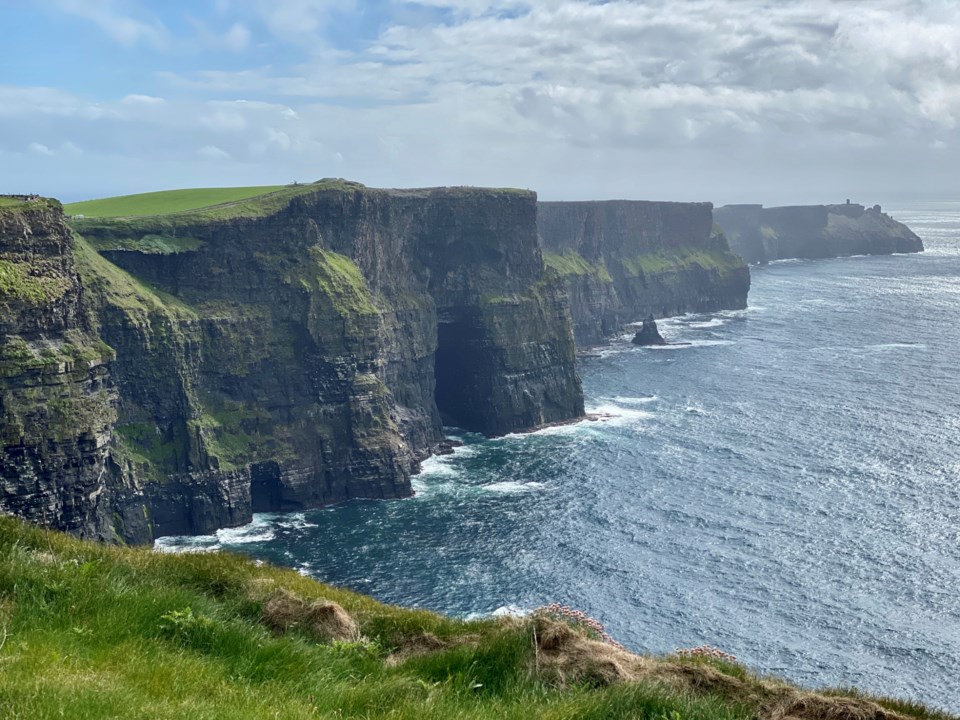My previous column (“The Wild Atlantic Way,” Pique, June 18), delved into a recent trip on which I was introduced to one of the world’s great tourism branding wins—the Wild Atlantic Way, a 2,500-kilometre network lacing Ireland’s labyrinthine and picturesque west coast from Donnegal to West Cork. I began my tale where we first parked ourselves: in Connemara, with its national park, big-mountain hikes, and splendiferous but oddly placed Kylemore Abbey.
In addition to stunning landscapes and almost constant ocean overlooks, quirk and charm began the moment we were checked into the historic Leenane Hotel (think The Shining) by a Swede whose fluent Swinglish carried a faintly Irish accent. This became a theme—a range of enthusiastic foreign nationals running hospitality businesses (like the genuine French bistro in Leenane), having taken advantage of a mobile EU and/or Ireland’s net immigration policy. Everyone we met who’d come from away loved living here; for most it was doubtless friendlier than their place of origin. Why? Because Ireland, which seems interminably hospitable.
Almost everyone loves to talk but no one cares who you are. One day we drove north to Westport, set in a deep recess of the archipelagic Clew Bay. Looking to stop, we turned into a seaside pub that was about to open. Since we were first through the door, the elderly bartender struck up an in-depth conversation covering Ukraine, Whistler, monkeypox, and the famous pilgrimage and residence of St. Patrick atop nearby 2,500-metre Croagh Patrick—all in the blink it took for our Guinness to settle. Tucking ourselves into an alcove with our pints, a woman in starched-whites appeared and shared that it was the bartender’s birthday; they’d made a cake and the staff was coming out of the kitchen to sing happy birthday; since we were clearly now his friends, would we like to join? “You can have some cake as well!” she whisper-shouted. It was actually pretty good.
Leaving Leenane we headed south to Clifden, an under-the-radar town where, in 1905, Guglielmo Marconi built the first high-power wireless telegraph station between Europe and North America (its sister station was in Glace Bay, Nova Scotia), and where the first transatlantic flight in 1919 crash-landed in a bog. We took Clifden’s real measure on the Sky Road, an 11-km drive along bays that rose 150m above sea level at Slyne Head, with views of the North Atlantic, Clifden Castle, nearby islands and the town.
Continuing south the next day, we backtracked around Galway Bay to the town where we’d spend several days—Doolin, which has recently morphed from local hangout of note to international tourist destination. I’d been there 34 years ago, when a friend I was staying with in Kilkee suggested we head up the coast to a pub where locals played music every night and the craic was good. We drove hours in darkness and pouring rain before a tiny light appeared in the maelstrom: Fitz’s Pub, set at the only intersection in town. Inside were farmers and peat-cutters in wellies; fishermen in big sweaters; a haze of smoke like you wouldn’t believe; and a fist of people in the corner playing pipes, hand drums, and fiddles, with audience members liberally switching in and out of the jam. It was magical.
In the intervening decades this grassroots scene gained fame as a showcase of Irish pub culture. Now a half-dozen pubs do the same thing every night, with a hundred hotels and B&Bs to accommodate the visitors. Having experienced the real thing in its infancy, we weren’t there for this slice of commercialized culture, but to hike and explore the nearby Burren and Cliffs of Moher UNESCO Global Geopark. We couldn’t quite escape the industrial tourism, however: the Cliffs of Moher, which I’d also checked out all those years ago by stumbling through a muddy cow pasture to their edge, now featured a parking lot that could accommodate 500 cars and 30 tour buses, a gift shop and other concessions, paved paths, and a €12-per-person charge for its annual 1.6 million visitors. The farmer who owned the cow pasture is making bank.
The Burren, happily, was yang to that yin: nobody around. You were in a Geopark but signs to that—or any—effect were at a premium. Finding the main trails wasn’t easy but the reward great, as it wound up onto the spectacular exposed former reefs and sediments of an ancient sea subsequently ground bare by Pleistocene glaciers, with rare flowers springing from fissures in the rock.
After the Burren, things took a beachy turn along the Dingle Peninsula, with endless sandy horseshoes to enjoy, a rainy high traverse across three peaks, B&Bs set in jungle-like surroundings, a hike to the westernmost point in Europe, and a chance meeting with a Vancouver friend who’d seen our Instagram posts and texted that he was in Inch Beach—which (map-wise) we were mere inches from. The surf town of Inch is basically that—a handful of houses and a pub—but the beach is a spectacular five-kilometre strand backed by mountains.
We wound up the trip at a friend’s place in West Cork in Ireland’s deep south, bathed in sun and beaches galore, surrounded by palm trees and ocean breezes, eating outdoors like Tuscan royalty, and daily hikes to headlands pocked with the remains of Ireland’s 30,000 (that’s right) castles. The Wild Atlantic Way, which stitched together so much geography and culture, delivered an enjoyably tame end.
Leslie Anthony is a biologist, writer and author of several popular books on environmental science.




